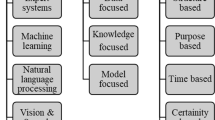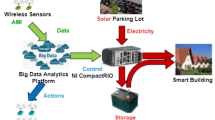Abstract
This study proposes a non-parametric efficiency frontier analysis method based on artificial neural network (ANN) and genetic algorithm clustering ensemble (GACE) for measuring efficiency as a complementary tool for the common techniques of the efficiency studies in the previous studies. The proposed ANN GA algorithm is able to find a stochastic frontier based on a set of input–output observational data and do not require explicit assumptions about the functional structure of the stochastic frontier. Furthermore, it uses a similar approach to econometric methods for calculating the efficiency scores. Moreover, the effect of the return to scale of decision making unit (DMU) on its efficiency is included and the unit used for the correction is selected based on its scale (under constant return to scale assumption). Also, in this algorithm, GA is used to cluster DMUs to increase DMUs’ homogeneousness. It should be noted that data envelopment analysis (DEA) is sensitive to the presence of the outliers and statistical noise. It is also not capable of performing prediction and forecasting. This is shown by two examples related to outlier situations. However, the proposed algorithm is capable of handling outliers and noise and DEA is used as a benchmark to show advantages of the proposed algorithm. Also, the proposed algorithm and conventional algorithm are compared in viewpoint of DEA through statistical t-test. The proposed approach is applied to a set of actual conventional power plants to show its applicability and superiority.
Similar content being viewed by others
References
Aarts, E. H. L., Eiben, A. E., & vanHee, K. M. (1989). A general theory of genetic algorithms. Tech.Rep.89/08, Einndhoven University of Thechnology.
Athanassopoulos A. D., Curram S. P. (1996) A comparison of data envelopment analysis and artificial neural networks as tool for assessing the efficiency of decision making units. Journal of the Operational Research Society 47(8): 1000–1016
Azadeh, A., Ghaderi, S. F., Anvari, M., & Saberi, M. (2006a). Measuring performance electric power generations using artificial neural networks and fuzzy clustering. In G. A. Capolino L. G. Franquelo (Eds.), Proceedings of the 32nd annual conference of the IEEE industrial electronics society. Paris, France: IECON.
Azadeh A., Ghaderi S. F., Anvari M., Saberi M. (2007a) Performance assessment of electric power generations using an adaptive neural network algorithm. Energy Policy 35: 3155–3166
Azadeh A., Ghaderi S. F., Anvari M., Saberi M., Izadbakhsh H. (2006b) An integrated artificial neural network and fuzzy clustering algorithm for performance assessment of decision making units. Applied Mathematics and Computation 187(2): 584–599
Azadeh A., Ghaderi S. F., Sohrabkhani S. (2007b) Forecasting electrical consumption by integration of neural network, time series and ANOVA. Applied Mathematics and Computation 186: 1753–1761
Azadeh, A., Ghaderi, S. F., Tarverdian, S., & Saberi, M. (2006c). Integration of artificial neural networks and GA to predict electrical energy consumption. In G. A Capolino & L. G. Franquelo (Eds.), Proceedings of the 32nd annual conference of the IEEE industrial electronics society-IECON’06. Paris, France: Conservatoire National des Arts & Metiers.
Azadeh A., Ghaderi S. F., Tarverdian S., Saberi M. (2007) Integration of artificial neural networks and genetic algorithm to predict electrical energy consumption. Applied Mathematics and Computation 186: 1731–1741
Azadeh, A., & Javanmardi, L. (2007). Studying impact of decision making units feature on efficiency by integration of data envelopment analysis and data mining tools. In International conference on operations research. German
Azimi, J., Mohammadi, M., Movaghar, M., Analoui, A., & Clustering, M. (2006). Ensembles using genetic algorithm. In International workshop on computer architecture for machine perception and sensing, 2006 CAMP (pp. 119–123).
Bauer P. W. (1990) Recent developments in the econometric estimation of frontiers. Journal of Econometrics 46(1–2): 39–56
Charnes A., Cooper W. W., Rhodes E. (1978) Measuring the efficiency of decision making units. European Journal of Operational Research 2(6): 429–444
Chiang W. C., Urban T. L., Baldridge G. W. (1996) A neural network approach to mutual fund net asset value forecasting. Omega, The International Journal of Management Science 24: 205–215
Cook W. D., Green R. H. (2005) Evaluating power plant efficiency: A hierarchical model. Computers & Operations Research 32(4): 813–823
Costa A., Markellos R. N. (1997) Evaluating public transport efficiency with neural network models. Transportation Research C 5(5): 301–312
Cybenko G. (1989) Approximation by superpositions of a sigmoidal function. Mathematics of Control, Signals and Systems 2: 303–314
Davis L. (eds). (1991). Handbook of genetic algorithms. New York, Van Nostrand Reinhold
Delgado F. J. (2005) Measuring efficiency with neural networks, an application to the public sector. Economics Bulletin 3(15): 1–10
Doyle J., Green R. (1994) Efficiency and cross-efficiency in DEA: Derivations, meanings and uses. Journal of the Operational Research Society 45(5): 567–578
Emami Meibodi, A. (1998). Efficiency considerations in the electricity supply industry: The case of Iran. A thesis submitted to university of Surrey for the degree of Doctor of Philosophy.
Fare R., Grosskopf S., Lovell C. A. K. (1983) The measurement of efficiency of production. Kluwer, Boston
Golany B., Yaakov R., Rybak D. (1994) Measuring efficiency of power plants in Israel by data envelopment analysis. IEEE Transactions on Engineering Management 41(3): 291–301
Goldberg D. E. (1989) Genetic algorithms in search optimization and machine learning. Addison-Wesley, New York
Goto M., Tsutsui M. (1997) Comparison of productive and cost efficiencies among Japanese and US electric utilities. Central Research Institute of Electric Power Industry, Tokyo, Japan
Hawdon, D. (1997). Improving the performance of electricity industries in developing countries: Is World Bank policy on deregulation the way forward. Economics Departmental Research Seminar, University of Surrey.
Hill T., O’Connor M., Remus W. (1996) Neural network models for time series forecasts. Management Science 42(7): 1082–1092
Hornik K., Stinchcombe M., White H. (1989) Multilayer feed forward networks are universal approximators. Neural Networks 2: 359–366
Indro D. C., Jiang C. X., Patuwo B. E., Zhang G. P. (1999) Predicting mutual fund performance using artificial neural networks. Omega, The International Journal of Management Science 27: 373–380
Jamasb, T., & Pollitt, M. (2001). Benchmarking and regulation of electricity distribution and transmission utilities: Lessons from international experience. DEA Working Paper, Cambridge, UK: Department of Applied Economics, University of Cambridge.
Jhee W. C., Lee J. K. (1993) Performance of neural networks in managerial forecasting. Intelligent Systems in Accounting, Finance and Management 2: 55–71
Knittel C. R. (2002) Alternative regulatory methods and firm efficiency: Stochastic frontier evidence from the US electricity industry. The Review of Economics and Statistics 84(3): 530–540
Kohzadi N., Boyd M. S., Kermanshahi B., Kaastra I. (1996) A comparison of artificial neural network and time series models for forecasting commodity prices. Neurocomputing 10(3): 169–181
Lam P., Shiu A. (2001) A data envelopment analysis of the efficiency of China’s thermal power generation. Utilities Policy 10: 75–83
Minaei, B., Topchy, A., & Punch, W. F. (2004). Ensembles of Partitions via Data Resampling. In Proceedings of the international conference on information technology, ITCC 04. Las Vegas.
Mohammadi, M., Davoodi, R., & Rahmani, A. (2007) A genetic based clustering method. In Proceedings of 12th annual international computer society of iran computer conference (CSICC).
Olatfubi W. O., Dismukes D. E. (2000) A data envelopment analysis of the level and determinants of coal-fired electric power generation performance. Utilities Policy 9: 47–59
Park S., Lesourd J. (2000) The efficiency of conventional fuel power plants in South Korea: A comparison of parametric and non-parametric approaches. International Journal of Production Economics 63: 59–67
Patuwo E., Hu M. Y., Hung M. S. (1993) Two-group classification using neural networks. Decision Sciences 24(4): 825–845
Pendharkar P. C. J. A., Rodger J. A. (2003) Technical efficiency-based selection of learning cases to improve forecasting accuracy of neural networks under monotonicity assumption. Decision Support Systems 36(1): 117–136
Pollit M. G. (1995) Ownership and performance in electric utilities. Oxford University Press, Oxford, UK
Rumelhart D. E., McClelland J. L. (1986) Parallel distributed processing: Explorations in the microstructure of cognition, Vol. 1, Foundations. MIT Press, Cambridge, MA
Sanhueza R., Rudnick H., Lagunas H. (2004) DEA efficiency for the determination of the electric power distribution added value. IEEE transactions on power systems 19(2): 919–925
Santin D., Delgado F. J., Valino A. (2004) The measurement of technical efficiency: A neural network approach. Applied Economics 36: 627–635
Stern H. S. (1996) Neural networks in applied statistics. Technometrics 38(3): 205–214
Strehl A., Ghosh J. (2002) Cluster ensembles—acknowledge reuse framework for combining multiple partitions. Journal on Machine Learning Research 3: 583–617
Strehl, A., & Ghosh, J. (2002). Cluster ensembles—a knowledge reuse framework for combining partitionings. In National Conference on Artificial Intelligence (pp. 93–98). AB, Canada.
Sueyoshi T., Goto M. (2001) Slack-adjusted DEA for time series analysis: Performance measurement of Japanese electric power generation industry in 1984–1993. European Journal of Operation Research 133: 232–259
Talluri S., Sarkis J. (1997) Extensions in efficiency measurement of alternate machine component grouping solutions via data envelopment analysis. IEEE Transactions on Engineering Management 44(3): 299–304
Tamura H., Tann K. (2008) Midpoint-validation method of neural networks for pattern classification problems. International Journal of Innovative Computing, Information and Control 4(10): 2475–2482
Tang Z., Almeida C., Fishwick P. (1991) A Time series forecasting using neural networks vs Box–Jenkins methodology. Simulation 57(5): 303–310
Tang Z., Fishwick P. A. (1993) Back-propagation neural nets as models for time series forecasting. ORSA Journal on Computing 5(4): 374–385
Tavanir Management Organization. (1997–2004). Electric power industry in Iran 1997–2004. Tavanir management organization.
Topchy, A., Minaei-Bidgoli B., Jain, A. K., & Punch, W. (2004). Adaptive Clustering ensembles. In Proceedings of the international conference on pattern recognition, ICPR’04 (pp. 272–275). Cambridge, UK.
Wang S. (2003) Adaptive non-parametric efficiency frontier analysis: a neural-network-based model. Computers & Operations Research 2003(30): 279–295
Wang X., Zhao X., Feng Y. (2008) A single parameter dynamic searching algorithm for multi-layer neural networks (part II). International Journal of Innovative Computing, Information and Control 4(11): 2941–2954
Wu D., Yang Z., Liang L. (2006) Using DEA-neural network approach to evaluate branch efficiency of a large Canadian bank. Expert Systems with Applications 31: 108–115
Zhang Z., Yang G., Yi J., Zhu Y. Y., Tang Z. (2008) A new stochastic dynamic adaptive local search algorithm for Elman neural network. International Journal of Innovative Computing, Information and Control 4(11): 2927–2940
Author information
Authors and Affiliations
Corresponding author
Rights and permissions
About this article
Cite this article
Azadeh, A., Saberi, M., Anvari, M. et al. An integrated artificial neural network-genetic algorithm clustering ensemble for performance assessment of decision making units. J Intell Manuf 22, 229–245 (2011). https://doi.org/10.1007/s10845-009-0284-8
Received:
Accepted:
Published:
Issue Date:
DOI: https://doi.org/10.1007/s10845-009-0284-8




